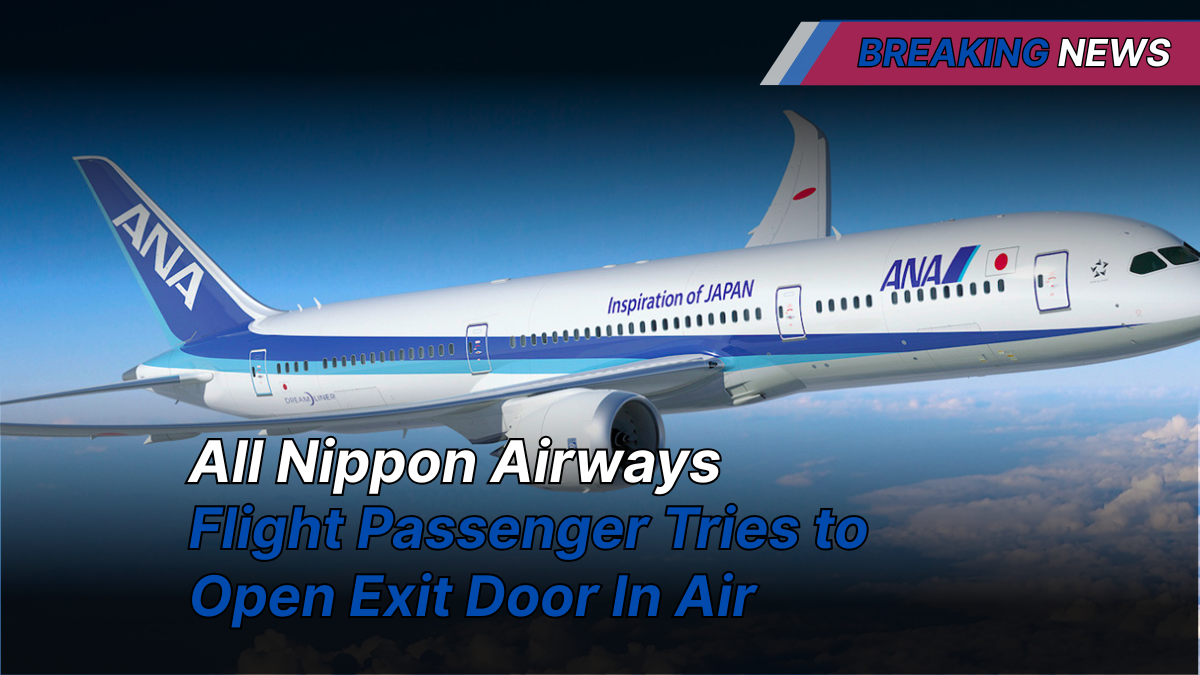On a routine international flight from Tokyo to Houston, a sudden in-flight emergency altered the course of events. An unruly passenger onboard an All Nippon Airways (ANA) aircraft attempted to open an emergency exit door mid-air. The flight, which was expected to proceed smoothly over the Pacific and continental United States, was forced to make an unscheduled landing in Seattle early Saturday morning due to the incident.
Summary Table: Unruly Passenger Forces Flight Diversion to Seattle

| Key Detail | Description |
|---|---|
| Flight | All Nippon Airways (ANA) Tokyo to Houston |
| Date of Incident | Saturday (Specific Date Not Provided) |
| Diversion Location | Seattle-Tacoma International Airport |
| Time of Landing in Seattle | 4:19 a.m. local time |
| Main Incident | Passenger attempted to open exit door mid-flight |
| Secondary Incident | Second passenger removed due to unrelated unruly behavior |
| Medical Response | First passenger taken to hospital for evaluation |
| Law Enforcement Response | Port of Seattle Police, FBI notified |
| Flight Status | Continued to Houston around 7 a.m. |
| Airline Statement | Applauded law enforcement and emphasized passenger and crew safety |
| Official Airline Site | https://www.ana.co.jp |
Timeline of the Incident
The disturbance occurred during the flight, prompting quick action from the airline crew and fellow passengers. The individual reportedly attempted to manipulate one of the aircraft’s emergency exit doors. While it is physically impossible to open these doors at cruising altitude due to cabin pressure differences, such attempts pose serious safety risks and psychological distress to others onboard.
The All Nippon Airways flight, operating from Tokyo’s Haneda Airport to George Bush Intercontinental Airport in Houston, was diverted and landed safely at Seattle-Tacoma International Airport at approximately 4:19 a.m. local time.
Response by Crew and Law Enforcement
The flight crew, assisted by other passengers, successfully restrained the individual. Upon arrival in Seattle, Port of Seattle Police officers were waiting to board the aircraft. Police determined that the passenger was experiencing a medical crisis and subsequently transported him to a local hospital for further evaluation.
As of now, it remains unclear whether the individual will face criminal charges. The incident is under review, and officials from the FBI’s Seattle branch were also contacted regarding the situation.
Secondary Incident Onboard
Adding to the challenges, a second unrelated incident occurred while the aircraft was on the tarmac in Seattle. Another passenger became unruly and had to be removed by law enforcement officials. All Nippon Airways confirmed that the second individual’s behavior was not connected to the first incident.
Continuation of the Flight
Despite the delays and disruption, the flight resumed its journey from Seattle to Houston just after 7 a.m., according to data from FlightAware.com. The airline thanked local authorities for their swift response and reassured the public that passenger and crew safety remains their highest priority.
Airline Statement
All Nippon Airways issued a public statement following the event:
“The safety of our passengers and crew are our top priority and we applaud the efforts of local law enforcement for their support.”
This response underscores the airline industry’s ongoing commitment to maintaining secure travel environments even under unpredictable circumstances.
Airline Safety Protocols for In-Flight Emergencies
This incident sheds light on the robust safety mechanisms and preparedness onboard modern aircraft. Emergency exit doors on commercial jets are designed to be inoperable at high altitudes due to cabin pressure. However, any attempt to interfere with emergency systems is taken seriously and can lead to legal and operational consequences.
Airlines train crew members extensively in crisis management, conflict de-escalation, and emergency medical response. Flight attendants are equipped not only with technical knowledge but also with psychological training to manage unruly behavior and ensure the well-being of all passengers.
Medical vs. Criminal Evaluation: Determining the Cause
In the case of the first passenger, authorities determined the behavior was linked to a medical crisis. When such incidents occur, airline and law enforcement protocol typically involves a multi-step evaluation:
- Initial Containment: Crew and passengers may physically restrain the individual if necessary.
- Medical Assessment: Upon landing, paramedics or hospital staff assess the individual’s condition.
- Legal Review: Authorities determine whether any laws were violated and if prosecution is warranted.
- Passenger Reporting: Witnesses and airline staff file detailed reports for investigative purposes.
Impacts of Diversions on Airline Operations
Emergency landings or unscheduled diversions can significantly impact airline operations, resulting in logistical adjustments, increased fuel costs, and delays. However, the safety of all onboard remains paramount. In cases like this, timely response and adherence to established protocols help mitigate risks.
Public Reactions and Industry Standards
Air travel has become one of the safest modes of transportation, but passenger behavior can introduce unpredictability. The aviation industry continues to evolve its standards for dealing with in-flight disruptions, often collaborating internationally to ensure consistent policy enforcement across borders.
With the rise of travel-related stress and mental health crises, airlines are also emphasizing partnerships with mental health professionals and revisiting protocols to offer more supportive solutions while preserving public safety.
FAQs
Q: Is it possible to open a plane’s exit door mid-flight?
A: No. Due to the pressurized environment at cruising altitudes, it is physically impossible to open an aircraft door while in the air.
Q: What happens when a passenger causes a disruption during a flight?
A: The crew will assess the threat level and may restrain the individual. If necessary, the flight will divert, and law enforcement will intervene upon landing.
Q: Can passengers be prosecuted for such actions?
A: Yes. Depending on the findings, disruptive passengers can face fines, jail time, or both, especially if intent to harm is established.
Q: Are mental health conditions considered in such evaluations?
A: Absolutely. If a medical crisis is suspected, passengers are evaluated and treated accordingly. Legal consequences depend on intent, mental state, and public safety risk.
Q: How are other passengers compensated in such situations?
A: Compensation policies vary by airline. Passengers affected by long delays or cancellations may be eligible for meals, accommodations, or refunds.
Conclusion
The ANA flight diversion to Seattle illustrates the complexities airlines face when managing in-flight emergencies. While such incidents are rare, they highlight the importance of preparedness, trained personnel, and cooperation between airlines, law enforcement, and medical professionals.
All Nippon Airways and the responding authorities acted swiftly to safeguard passengers and restore order. The flight’s eventual continuation to Houston marked a successful resolution to what could have been a far more serious situation. As air travel resumes normalcy post-pandemic, ensuring a safe, respectful, and cooperative travel environment remains a shared responsibility for all onboard.
For More Information Click Here







